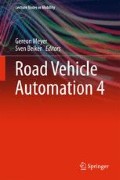Abstract
Transportation-related energy consumption and air quality problems have continued to attract public attentions. A variety of emerging technologies have been proposed and/or developed to address these issues. In recent years, electric vehicles (EVs) are deemed to be very promising in reducing traffic related fuel consumption and pollutant emissions, due to the use of electric batteries as the only energy source. On the other hand, recent research shows that additional energy savings can be achieved with the aid of Eco-driving system in a connected vehicle environment (e.g., Eco-approach at signalized intersections). However, most of the existing eco-driving research is only focused on the internal combustion engine (ICE) vehicles thus far. There is still lack of convincing evidence (especially with real-world implementation) of how these connected eco-driving technologies impacts the energy efficiency of EVs. To fill this gap, this chapter provides a real-world example of quantifying the energy synergy of combining vehicle connectivity, vehicle automation and vehicle electrification, by designing, implementing and testing an eco-approach and departure (EAD) system for EVs with real-world driving data.
Access this chapter
Tax calculation will be finalised at checkout
Purchases are for personal use only
References
Barth M, Mandava S, Boriboonsomsin K, Xia H (2011) Dynamic eco-driving for arterial corridors. IEEE forum on integrated and sustainable transportation system (FISTS), Vienna, pp 182–188
Canis B (2011) Battery manufacturing for hybrid and electric vehicles: policy issues. Congressional research service. http://nepinstitute.org/get/CRS_Reports/CRS_Energy/Energy_Efficiency_and_Conservation/Batteries_for_Hybrid_and_Elec_Vehicles.pdf. Accessed 10 Apr 2013
Elkind EN (2012) Electric drive by ’25: how California can catalyze mass adoption of electric vehicles by 2025, Workshop by UCLA Law/Berkeley Law. www.law.berkeley.edu/files/ccelp/Electric_Drive_by_25-2.pdf. Accessed 22 Apr 2013
Flehmig F, Sardari A, Fischer U, Wagner A (2015) Energy optimal adaptive cruise control during following of other vehicles. In: IEEE intelligent vehicles symposium (IV), Seoul, pp 724–729
Frank R, Castignani G, Schmitz R, Engel T (2013) A novel eco-driving application to reduce energy consumption of electric vehicles. In: International conference on connected vehicles and expo (ICCVE), Las Vegas, NV, pp 283–288
Kamal MS, Mukai M, Murata J, Kawabe T (2013) Model predictive control of vehicles on urban roads for improved fuel economy. IEEE Trans Control Syst Technol 21(3):831–841
Koehler S, Viehl A, Bringmann O, Rosenstiel W (2015) Improved energy efficiency and vehicle dynamics for battery electric vehicles through torque vectoring control. In: IEEE intelligent vehicles symposium (IV), Seoul, pp 749–754
Miyatake M, Kuriyama M, Takeda Y (2011) Theoretical study on eco-driving technique for an electric vehicle considering traffic signals. In: IEEE ninth international conference on power electronics and drive systems (PEDS), Singapore, pp 733–738
Skerlos SJ, Winebrake JJ (2010) Targeting plug-in hybrid electric vehicle policies to increase social benefits. Energy Policy 38(2):705–708
US DOT (2010) Transportation’s role in reducing U.S. greenhouse gas emissions, synthesis report, vol 1, report to congress, U.S. Department of Transportation
U.S. Energy Information Administration: Monthly Energy Review, Table 2.1, Mar 2015. www.eia.gov/Energyexplained/?page=us_energy_transportation
U.S. Environmental Protection Agency (EPA): inventory of U.S. greenhouse gas emissions and sinks: 1990–2014, Final report, Apr 2016
Zhang R, Yao E (2015) Eco-driving at signalised intersections for electric vehicles. IET Intell Transp Syst 9(5):488–497
Author information
Authors and Affiliations
Corresponding author
Editor information
Editors and Affiliations
Rights and permissions
Copyright information
© 2018 Springer International Publishing AG
About this paper
Cite this paper
Qi, X., Barth, M.J., Wu, G., Boriboonsomsin, K., Wang, P. (2018). Energy Impact of Connected Eco-driving on Electric Vehicles. In: Meyer, G., Beiker, S. (eds) Road Vehicle Automation 4. Lecture Notes in Mobility. Springer, Cham. https://doi.org/10.1007/978-3-319-60934-8_10
Download citation
DOI: https://doi.org/10.1007/978-3-319-60934-8_10
Published:
Publisher Name: Springer, Cham
Print ISBN: 978-3-319-60933-1
Online ISBN: 978-3-319-60934-8
eBook Packages: EngineeringEngineering (R0)

